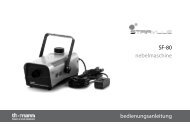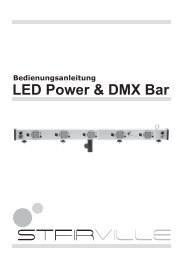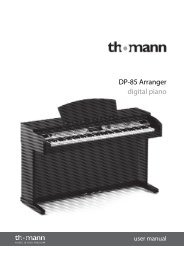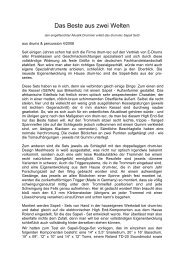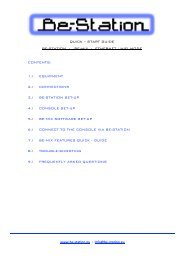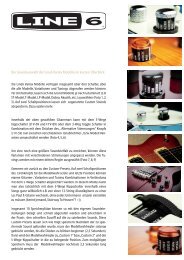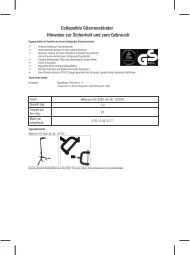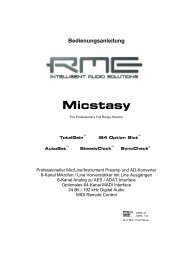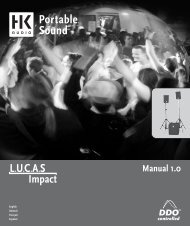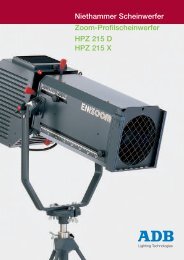Create successful ePaper yourself
Turn your PDF publications into a flip-book with our unique Google optimized e-Paper software.
Bus traffic problems<br />
You may find it particulatly difficult to achieve low latencies on laptops and smaller machines with limited expansion potential – no<br />
ability to install dedicated internal drives or audio interfaces. This means you may need to chain devices on the same firewire bus,<br />
for example. This often leads to dropouts at lower latencies.<br />
It is highly recommended to run the hard drive containing BFD2’s sounds from a separate bus to the audio interface. Numerous<br />
options are available – Cardbus or ExpressCard Firewire/E-SATA cards are one option, while USB2 hard drives or audio interfaces<br />
represent another solution. Some laptops feature fast 7200 RPM internal drives – in such cases, running BFD2’s sounds from<br />
the internal drive is another potential option.<br />
Recommended systems for low latency<br />
If you’re serious about drumming with BFD, you must assemble a system which can get down to very playable low latencies. Audio<br />
interfaces such as those by RME and Lynx can deliver latencies as low as 64 or 32 samples (1.5ms or 0.75ms at 44.1 kHz).<br />
A PCI or PCI-Express solution is recommended, with CardBus and ExpressCard interfaces on laptops being of similar quality.<br />
A Firewire interface on its own bus is the next best option in our experience.<br />
An internal 7200 RPM drive for the sounds is preferable – if this is not possible, use an external drive on its own bus (Firewire,<br />
USB2 and E-SATA are all potential options).<br />
If you also use a good MIDI interface (PCI/PCI-Express is better than USB) and a fast computer, you can achieve a very responsive<br />
feel when playing BFD2 with e-drums.<br />
If it is not possible to assemble a system capable of stable low latency operation, it may be best to record your performance while<br />
monitoring the sounds in your drum brain, and then afterwards route the recorded MIDI to BFD2’s sounds.<br />
9:2 Simple hihat control<br />
The easiest way to control BFD2 hihats with an electronic kit is by ignoring the MIDI CC transmitted by the brain according to the<br />
hihat pedal position and instead simply using the open, closed and pedal hihat notes transmitted by the brain.<br />
The drum brain calculates whether to send out an open or closed hihat note depending on the state of the hihat pedal. Some<br />
brains that support multi-zone triggers are capable of sending out different open and closed notes for tip (also known as bow) and<br />
shank (edge) triggers. A pedal note is transmitted when the hihat pedal controller is fully depressed.<br />
These notes are mapped to suitable BFD2 articulations.<br />
Example: Roland TD-20<br />
The following table shows how to map the notes transmitted by a Roland TD-20 to achieve non-variable hihat control.<br />
Roland note<br />
Open Bow<br />
Closed Bow<br />
Open Edge<br />
Closed Edge<br />
Pedal<br />
MIDI note (note no.)<br />
A#1 ( )<br />
F#1 ( )<br />
D0 ( )<br />
A#-1 ( )<br />
G#1 ( )<br />
1<br />
default BFD mapping<br />
open tip<br />
closed tip<br />
open shank<br />
closed shank<br />
pedal<br />
It is highly recommended to remap A#1 and D0 to 1/2-open tip and 1/2-open shank, as these represent the most common type of<br />
open hat sound. The open tip articulation in particular is more like a hihat bell sound, or a small ride cymbal.<br />
Advantages and disadvantages of non-variable hihat control<br />
While it may be argued that using this method is less expressive than using a variable hihat control method, it offers a distinct<br />
advantage.<br />
When recording in a MIDI sequencer, the resulting MIDI data is much easier to edit. When using a MIDI CC for the hihat pedal<br />
position, you need to move or copy the recorded CC values along with any notes when editing. This can be cumbersome.<br />
If you use the simple hihat control method, any editing and quantizing you need to do are also much more straightforward. You<br />
can move notes to other articulations after recording to make parts more expressive.



